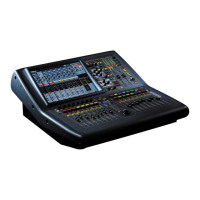144 Chapter 16: Internal Effects
PRO1 Live Audio System
Operator Manual
Ambience reverb
The ambience reverb adds warmth and depth to source material without adding the
obvious artefacts commonly associated with artificial reverbs. It simulates smaller
rooms using diffuse early reflections with the additional flexibility of separate reverb tail
level and decay control.
Reflective surface materials and air absorption properties can be simulated by adjusting
the high and low frequency cut amount and high frequency damping.
Item Element Function
1 input meter Two adjacent 11-LED columns — one each for left and
right — comprise the input meters.
2 Mix control knob Adjusts the dry/wet signal ratio.
3 Modulation
control knob
Specifies the combined rate and depth of modulation
applied the reverb tail.
4 In switch Switches the Plate Reverb effect in/out.
5 Audition button This momentary-action button triggers a short
internally generated sound to aid reverb evaluation
(as a check).
6 output meter Two adjacent 11-LED columns — one each for left and
right — comprise the output meters.
7 HF Cut control
knob
High frequency cut control knob applies a 6dB/Oct
low pass filter to the input signal, in the range 200Hz
to 20kHz.
8 LF Cut control
knob
Low frequency cut control knob applies a 6dB/Oct
high pass filter to the input signal, in the range 10Hz
to 500Hz.
9 HF Damp control
knob
High frequency damping, progressively reduces the
high frequency content over time, in the range 1kHz
to 20kHz.
10 Tall Gain control
knob
Increases the level of the reverb tail, between off and
0dB.
11 Diffusion control
knob
Increases the density of both the early reflections and
reverb tail, between 0 and 100%.
12 Decay control
knob
Adjusts the decay time relative to the room size, from
minimum to maximum.
13 Size control knob Specifies the room size (also affects decay), from
small to large.
14 Predelay control
knob
Specifies the time before the reverb begins, between
0ms and 200ms.
6
15 14 12 11 10 9 8 7
1
42 3 5

